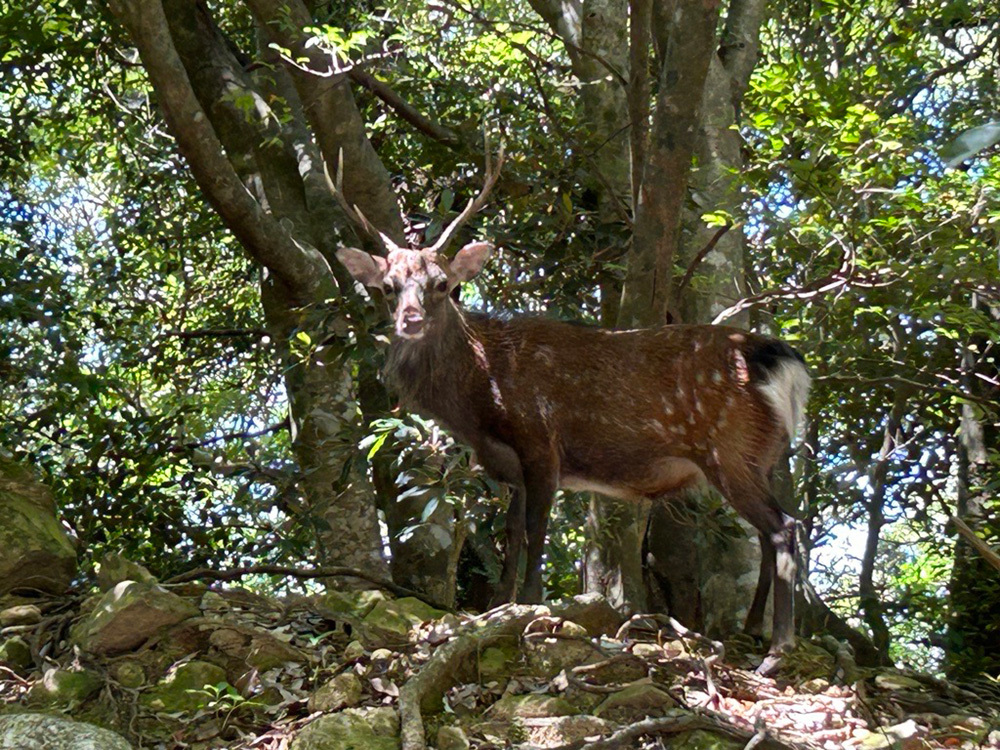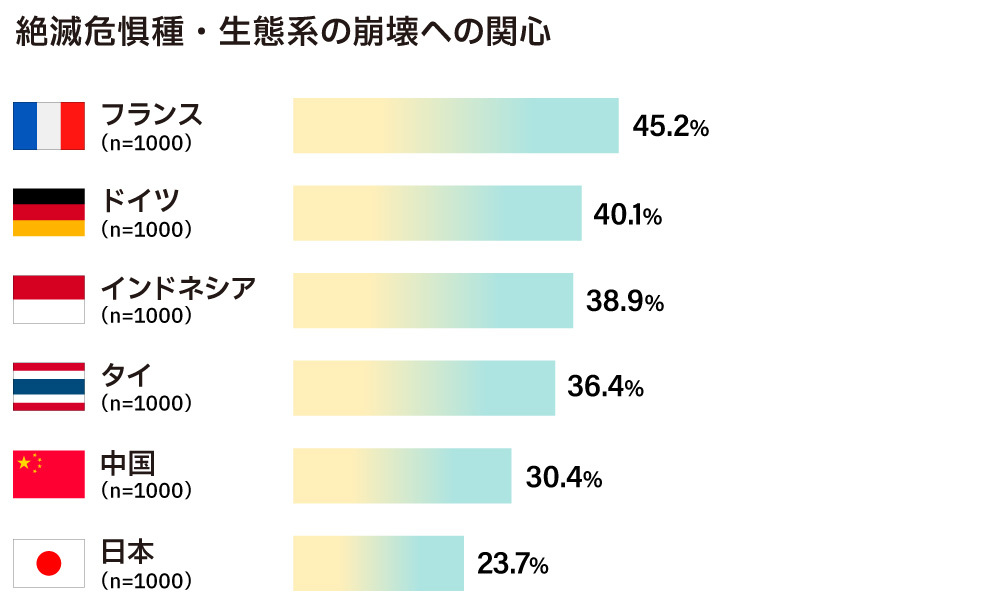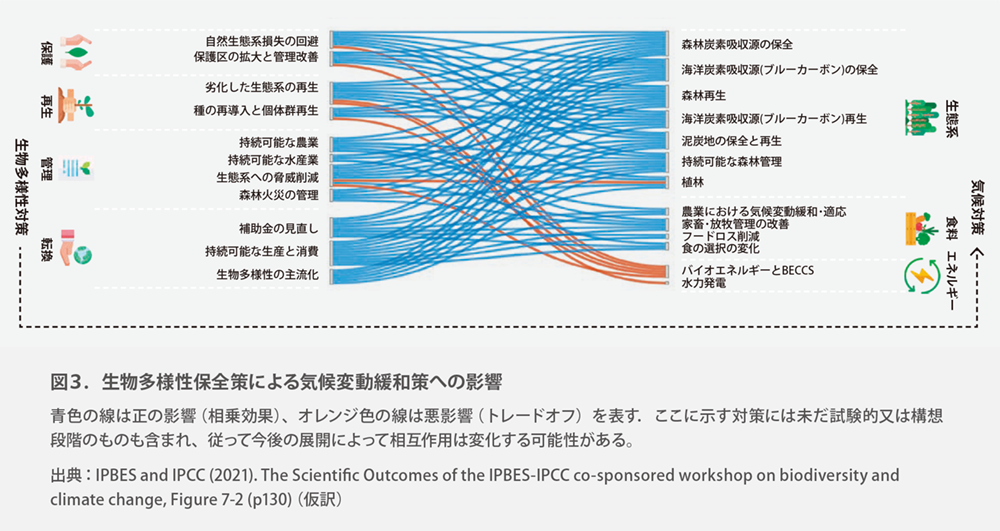90% Aware on Average Across 6 Countries!? "Biodiversity" ―Exploring Why It's Gaining Business Attention―

Biodiversity is one of the issues currently attracting global attention. In Japan, corporate initiatives are increasingly featured in TV programs and advertisements, sparking interest in how to integrate this into business practices.
The first half of this article introduces responses to biodiversity from six countries (Japan, China, France, Germany, Indonesia, Thailand) based on the results of the " Sustainable Lifestyle Awareness Survey 2023 " ( survey overview here ). The latter half features an interview with Kaori Suzuki and Benoît Morgan of Codo Advisory, who translated the France-originated "Biodiversity Workshop" into Japanese and have been rolling it out in Japan since 2023.
<Table of Contents>
▼Awareness of "Biodiversity" Averages Around 90% Across Six Countries
▼ "Water Conservation" Gains Increasing Attention Within Biodiversity
▼The France-Origin Biodiversity Workshop
▼Surprisingly Unknown Aspects of Biodiversity
▼Biodiversity Measures That Also Address Climate Change
Awareness of "biodiversity" averages around 90% across six countries
Awareness of the term "biodiversity" averages about 90% across six countries, while understanding averages about 60%. Japan's awareness of biodiversity was 78.7%. Although understanding at 43.3% is lower than the six-country average, it shows the term itself is widely recognized.

Although this is a reference value due to differences in target age groups and survey methods compared to the current survey, a public opinion survey released by the Japanese government in October 2022 (surveying 3,000 Japanese nationals aged 18 and over) showed awareness of biodiversity(※1) at 72.6% and understanding at 29.4%. It is possible that both awareness and understanding have increased over the past year.
Source: Cabinet Office Public Relations Office / Overview of "Public Opinion Survey on Biodiversity"
※1: Total of those who knew the meaning of the term and those who had heard the term but did not know its meaning
Next, the countries with the highest percentages selecting "Endangered Species and Ecosystem Collapse" as a social issue of concern were France (45.2%) and Germany (40.1%).

France enacted the "Law on the Restoration of Biodiversity, Nature, and Landscapes" in 2016. This law stipulates the protection of ecosystems and the restoration of biodiversity, reflecting a national commitment to biodiversity.
In contrast, Japan showed the lowest level of concern for endangered species and ecosystem collapse among the six countries, at 23.7%. While awareness and understanding of biodiversity are increasing, interest in endangered species and ecosystem collapse remains low.
Water Conservation: A Growing Focus Within Biodiversity
Over 1,000 companies and organizations worldwide participate in the international initiative TNFD (Taskforce on Nature-related Financial Disclosures). More than 130 organizations from Japan are also involved, and the number of companies actively disclosing information continues to grow. So, what specific actions do people expect companies to take?
When presented with representative biodiversity-related initiatives and asked which they would prefer companies to prioritize, "water source conservation and water quality management" ranked highly in all six countries surveyed. Amidst growing global discussions about water scarcity, including in Japan, this shows that initiatives related to "water" – directly impacting daily life – are also being demanded of companies.

In Japan, various companies, including beverage manufacturers, are intensifying their water conservation activities. They are not only preserving forests as water sources and curbing biodiversity loss but also beginning to communicate their commitment to achieving Nature Positive (nature restoration). Furthermore, with expert collaboration, companies are now quantifying and visualizing the ecological impacts of their longstanding nature conservation efforts—previously conducted as CSR activities—and leveraging these insights for corporate and business branding.
Furthermore, there is a movement to apply for designation of corporate-owned forests and satoyama landscapes as "Nature Coexistence Sites" (areas where biodiversity conservation is achieved through private initiatives). The Ministry of the Environment certified 122 such sites in October 2023.
The total area is approximately 77,000 hectares, equivalent to about 0.2% of Japan's land area—larger than the 23 wards of Tokyo. Even so, this is still insufficient to meet the 30by30 target (the goal to conserve at least 30% of Japan's land area as natural environment areas by 2030) pledged at the 2021 G7 Summit.
Both the government and the public are calling for increased conservation areas through greater collaboration between companies, local governments, and environmental groups on nature conservation activities, which also contribute to water conservation. The trend where water-using companies go beyond CSR and social contribution initiatives, reframing conservation as part of their core business operations while communicating it as brand value ( ), is likely to accelerate further.
Biodiversity Workshop from France
The biodiversity workshop "Biodiversity Collage" (official name: La Fresque de la Biodiversité), originating in France, is featured on the French government's Biodiversity Agency website. In France, this workshop has been selected for climate education for civil servants. By the end of 2024, it is planned to reach 25,000 senior officials, with a future target of 5.6 million civil servants.
This time, we speak with Kaori Suzuki, CEO of Codo Advisory—a company holding an official license for the Biodiversity Workshop and operating in Japan—and Benoît Morgan, the certified facilitator representing Japan.

──What kind of workshop is "Biodiversity Collage"?
Suzuki: It's a workshop using cards and collages created based on the globally recognized, scientifically credible IPBES (※2) report. Its key features are that it's fun, scientific, and objective, allowing participants to gain foundational knowledge about biodiversity.
※2=IPBES
An intergovernmental organization established in April 2012. It stands for the Intergovernmental Science-Policy Platform on Biodiversity and Ecosystem Services. It scientifically assesses trends in biodiversity and ecosystem services and strengthens the link between science and policy.

Benoit: In the first half, we use cards to learn about the causes and consequences of biodiversity collapse. Specifically, we present problems related to "ecosystems" – the relationships where organisms maintain ecological balance through food chains and other interactions – and discuss them with all participants. Using cards, we explore the complex balance of biodiversity, consider how humans impact these ecosystems, share our feelings, and experience the structure of ecosystems firsthand.

Benoa: In the latter half, we'll discuss actions to prevent biodiversity loss. This part can be customized for companies. For example, we'll break actions into industry actions, company actions, and individual actions, and list what should be done at each level. Participants will present these ideas to each other and discuss them, fostering ownership and accelerating future action.
──What is the purpose of participating in the workshop?
Suzuki: The primary purpose is corporate sustainability training and promoting understanding of biodiversity within companies. Many participants aim to learn about biodiversity systematically because they don't fully understand it. We also receive requests from local governments and universities. The workshop is accessible to both beginners and those from highly specialized departments. No complex tools are required; all we need is a large table to conduct the session.
Biodiversity: Surprisingly Unknown

──I actually participated in a workshop myself and was surprised by how much I didn't know about biodiversity.
Benoa: During the initial self-introductions, I asked participants, "Please tell us your favorite living thing." Most people answered with mammals like dogs or cats. Occasionally, someone would mention reptiles, but almost no one answered with plants or fungi. Even if people think they know about biodiversity, they often don't realize that ecosystems like forests and oceans are also biodiversity, and that we are actually supported by all forms of biodiversity.
──When we hear "biodiversity," we often think of protecting endangered species, but it's actually much broader—it includes forest conservation and protecting water sources. Through this workshop, I learned anew that we are supported by the balance of all ecosystems and truly felt that humans are just one part of the ecosystem.
Benoa: I would be delighted if many people could recognize their own connection to biodiversity and experience how accumulating small actions can lead to meaningful results.
Suzuki: Biodiversity can seem complex, but this workshop offers an intuitive and enjoyable way to learn. We hope it serves as a first step for people to proactively engage with biodiversity.
Biodiversity measures that also combat climate change
──Could you briefly explain the data presented in the workshop showing how biodiversity conservation, jointly reported by IPBES and IPCC (※3), impacts climate change?
※3=IPCC
The Intergovernmental Panel on Climate Change (IPCC), an intergovernmental organization established in 1988 by the World Meteorological Organization (WMO) and the United Nations Environment Programme (UNEP)

Benoit: Figure 2 above illustrates the impacts of climate change mitigation measures on biodiversity conservation. The left side represents climate change, and the right side represents biodiversity. It shows how actions on the left affect the right. Blue indicates positive impacts, and red indicates negative impacts. It is said that measures focused solely on climate change mitigation and adaptation may have direct or indirect negative impacts on some aspects of nature and its benefits.
Figure 3 below shows how biodiversity conservation measures affect climate change mitigation measures. The left side represents biodiversity, and the right side represents climate change. Compared to Figure 2, most effects are shown in blue, indicating positive impacts. It is reported that even measures focused solely on protecting and restoring biodiversity often have spillover effects on climate change mitigation. However, it is also noted that it is important to implement measures that consider both biodiversity and climate, rather than focusing on just one.
──Biodiversity and climate change are often described as twins, and this data clearly shows how vital biodiversity conservation is.
Some companies may be unaware that their nature conservation activities are contributing to biodiversity. I feel that re-evaluating their actions with the question, "Could this be biodiversity-related?" is the first step toward becoming Nature Positive. Thank you for today!
[Survey Overview]
Target Areas: 6 countries (Japan, China, France, Germany, Indonesia, Thailand)
Respondent Criteria: Ages 18–69 (Gender response options: "Male," "Female," "Other/Prefer not to say")
Sample Size: 6,000 people (1,000 per country)
Survey Method: Online survey
Survey Period: July 12 to August 21, 2023
Was this article helpful?
Newsletter registration is here
We select and publish important news every day
For inquiries about this article
Back Numbers
Author

Yuka Sawai
Dentsu Inc.
After working at an HR-focused creative agency, I joined Dentsu Inc. As a business producer, I handled the beverage, food, AI, and cosmetics industries, focusing on brand management while also engaging in advertising production, new product development, and business launches. After welcoming a rescue cat into my family, my awareness of social issues grew, leading me to the Sustainability Consulting Office. In my current role, I work across various sustainability domains, primarily focusing on biodiversity. I love cats, beer, and camping.





